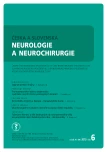Oculopharyngeal Muscular Dystrophy in the Population of the Czech Republic
Authors:
R. Mazanec 1; P. Seeman 2,3; E. Seemanová 4
Authors‘ workplace:
Neurologická klinika 2. LF UK a FN v Motole, Praha
1; DNA laboratoř Kliniky dětské neurologie 2. LF UK a FN v Motole, Praha
2; Centrum lékařské genetiky Gennet, Praha
3; Oddělení klinické genetiky Ústavu biologie a lékařské genetiky 2. LF UK a FN v Motole, Praha
4
Published in:
Cesk Slov Neurol N 2013; 76/109(6): 717-722
Category:
Short Communication
Overview
Oculopharyngeal muscular dystrophy is an autosomal dominant muscular dystrophy due to amplification of the GCG triplet in the polyadenylate binding protein nuclear 1 gene (PABPN1) located on chromosome 14q11.2–q13. The first symptoms, usually facial muscle weakness, frequently occur in the fourth or sixth decade; other symptoms include dysphagia, progressive ptosis of the upper eyelids as well as weakness of limb-girdle muscles and sometimes anal or urethral sphincter weakness. The prevalence of the mutation varies depending on geographic region (the highest prevalence was found in Bukchara Jews in Izrael 1 : 600 and in Quebec 1 : 1,000 and very low in France 1 : 200,000). This mutation is very stable and shows no anticipation phenomenon. We correlated the phenotype and genotype of 36 patients from five independent families and we found no correlation between the onset of symptoms, progression, severity of phenotype and number of triplet GCG repetitions. The prevalence of OPMD in the Czech Republic can only be estimated (35/10 million, i.e. 1 : 285,700) and carriers of mutation and permutation, respectively, are substantially more common, because the majority of young relatives of probands with 50% genetic risk refused presymptomatic testing.
Key words:
oculopharyngeal muscle dystrophy – PABPN1 protein – trinucleotid repeat expansion – ptosis – dysphagia – limb-girdle myopathy
The authors declare they have no potential conflicts of interest concerning drugs, products, or services used in the study.
The Editorial Board declares that the manuscript met the ICMJE “uniform requirements” for biomedical papers.
Sources
1. Brais B, Xie ZG, Sanson M, Morgan K, Weissenbach J, Korcyn AD et al. The oculopharyngeal muscular dystrophy locus maps to the region of the cardiac alpha and beta myosin heavy chain genes on chromosome 14q11.2 – q13. Hum Mol Genet 1995; 4(3): 429 – 434.
2. McKusick VA. Mendelian inheritance in man [on-line]. Mendelian Inheritance in Man. Available from URL: http:/ / OMIM.org.
3. Blumen SC, Nisipeanu P, Sadeh M, Asherov A, Blumen N, Wirguin Y et al. Epidemiology and inheritance of oculopharyngeal muscular dystrophy in Israel. Neuromuscular Disord 1997; 7 (Suppl 1): S38 – S40.
4. Brais B, Bouchard JP, Jomphe M. When genetics and history converge: the fine mapping and North American introduction and diffusion of the French Canadian oculopharyngeal muscular dystrophy mutation. Am J Hum Genet 1998; 63 : 229.
5. Blumen SC, Korczyn AD, Lavoie H, Medynski S, Chapman J, Asherov A et al. Oculopharyngeal muscular dystrophy among Bukhara Jews is due to a founder (GCG)9 mutation in the PABP2 gene. Neurology 2000; 55(9): 1267 – 1270.
6. Bouchard JP, Brais B, Brunet D, Gould PV, Rouleau GA. Recent studies on oculopharyngeal muscular dystrophy in Quebec. Neuromuscular Disord 1997; 7 (Suppl 1): S22 – S29.
7. Dionne A, Bouchard JP. Oculopharyngeal Muscular Dystrophy. In: Tawil RN, Venance S (eds). Neuromucular Disorders. 1st ed. Chichester: Willey ‑ Blackwell 2011 : 87 – 90.
8. Brais B, Rouleau GA. Oculopharyngeal muscular dystrophy. In: Katirji B, Kaminski HJ, Ruff RL et al (eds). Neuromuscular Disorders in Clinical Practice. 1st ed. Newton, MA: Buttenworth ‑ Heinemann 2002 : 1101 – 1105.
9. Blumen SC, Bouchard JP, Brais B, Carasso JL, Paleacu D, Drory VE et al. Cognitive impairment and reduced life span of oculopharyngeal muscular dystrophy homozygotes. Neurology 2009; 73(8): 596 – 601.
10. Jones LK jr, Harper CM. Clinical and electrophysiologic features of oculopharyngeal muscular dystrophy: lack of evidence for an associated peripheral neuropathy. Clin Neurophysiol 2010; 121(6): 870 – 873.
11. Piccolo G, Cortese A, Tavazzi E, Piccolo L, Sassone J, Ciammola A et al. Late onset oculopharyngeal muscular dystrophy with prominent neurogenic features and short GCG trinucleotide expansion. Muscle Nerve 2011; 43(1): 141 – 142.
12. Tomé FM, Chateau D, Hlebling ‑ Leclerc A, Fardeau M.Morphological changes in muscle fibers in oculopharyngeal muscular dystrophy. Neuromuscul Disord 1997; 7 (Suppl 1): S63 – S69.
13. Catoire H, Pasco MY, Abu ‑ Baker A, Holbert S, Tourette C, Brais B et al. Sirtuin inhibition protects from the polyalanine muscular dystrophy protein PABPN1. Hum Mol Genet 2008; 17(14): 2108 – 2117.
14. Davies JE, Wang L, Garzia ‑ Oroz L, Cook LJ, Vacher C, O’Donovan DG et al. Doxycycline attenuates and delays toxicity of the oculopharyngeal muscular dystrophy mutation in transgenic mice. Nat Med 2005; 11(6): 672 – 677.
Labels
Paediatric neurology Neurosurgery NeurologyArticle was published in
Czech and Slovak Neurology and Neurosurgery

2013 Issue 6
Most read in this issue
- Frontotemporal Lobar Degeneration from the Perspective of the New Clinical‑ Pathological Correlations
- Tuberous Sclerosis Complex in Children Followed from Neonatal Period for Prenatally Diagnosed Cardiac Rhabdomyoma – Two Case Reports
- Pineal Region Expansions
- Occipital Condyle Fractures
